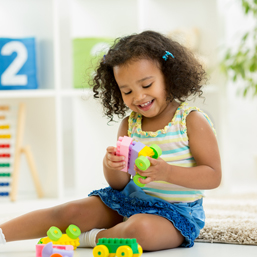
You hear it everywhere… ‘You should set up an intentional play space for your child.’ But what exactly does that mean? An intentional play space is an environment filled with invitations to play.
In the Montessori approach, we call this a ‘prepared environment,’ and it is a major part of the philosophy. Children in the first plane of development, birth to six years, and especially from the ages three to six, have an innate desire to be independent. Maria Montessori called these years the ‘Help Me Help Myself’ stage. An intentional play space is prepared to help your child be as independent as possible, which allows them the freedom to choose their activity and promotes longer engagement sessions with those activities.
Creating a ‘prepared environment’ doesn’t have to be hard or complicated. Here are a few easy-to-incorporate tips on how to create an intentional play space in your home:
Create a space that revolves around your child. This should include child-size furniture, toy shelves at their level, and toy visibility. Stay away from closed boxes and bins as they tend to encourage clutter. Display their toys on a tray or directly on a shelf instead. Their toys should act as a consistent invitation to play. Having toys displayed in your child’s view, instead of hidden away in a box or bin, acts as a motivator for them to engage.
Order in the environment equals order in the mind. Children thrive in an environment that has a sense of order. Children ages three to six are in the sensitive period for order, meaning they crave and developmentally need order during this time. A lot of parents don’t realize this is a need for their child because most children have never had this need met. Messy and cluttered playrooms are all too often seen as the norm.
How can you help your child thrive in their environment?
Firstly, less is more. I know it’s a cliché but when it comes to your child’s play space, it is important to minimize their toys. Secondly, everything must have its place. What I mean by this is to plan out your child’s toy placement and always return their toys to that place. This helps create a sense of order in their environment, which gives them a sense of control over their life.
I’ve told you all about how to set up your child’s toys, but which toys are best?
The answer to this question is purposeful toys! Choosing purposeful toys is the key to a great intentional play space and is important for child development. What are purposeful toys? I like to think of purposeful toys as toys with a purpose other than a plain distraction. Distraction toys are created to distract your child for a short period of time, instead of truly engaging them. If you are wondering how to spot a distraction toy, look for these red flags: Loud, flashy, and busy.
When choosing purposeful toys, it is important to help give your child real sensory experiences through the toys they interact with every day. A great way to do this is to choose wooden materials over plastic, anytime you can. Using a natural material like wood allows your child to engage their senses in ways plastic does not offer. For instance, wood gets noticeably heavier with size, helping them understand and compare weight and size. Wood warms to the touch and cools in its environment, engaging the tactile sense. Depending on the shape and size, wood can make a variety of noises engaging the sense of hearing. On top of this, wood is naturally beautiful, is appealing to children, and is durable.
Another great guideline for choosing purposeful toys is to follow their development
Give them toys they can enjoy while also providing a developmental need. These developmental needs can be anything from fine motor skills and hand-eye coordination to problem-solving skills and concentration levels.
An excellent way to motivate them to do activities that help provide a developmental need is to follow their interests. For instance, if you want your child to build early hand skills and they love dinosaurs, you can set up a play dough activity that includes wooden dinosaur stamps. Maneuvering the play dough and stamps help build their hand and wrist strength, pincer grasp and hand-eye coordination (just to name a few), while the dinosaurs act as a motivator for the child to do the activity, increasing the likelihood that they will choose it independently. Along with this, when you include your child’s interests in activities that engage multiple senses and help build skills, you are also helping them develop longer concentration levels.
Purposeful toys truly engage your child. They provide sensory experiences and build essential child-development skills. When you set up an intentional play space filled with purposeful toys, you are providing your child with unlimited opportunities for play.
Jenna is a mother, Montessori teacher, and owner of Evolve Montessori. Evolve Montessori offers unique and exceptional Montessori programs for kids ages two to four. For more information, email This email address is being protected from spambots. You need JavaScript enabled to view it. or visit evolvemontessori.com. Feeling Social? Follow on Facebook and Instagram.
Calgary’s Child Magazine © 2024 Calgary’s Child